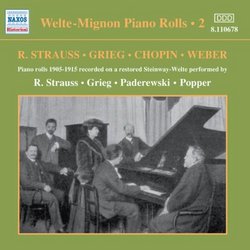| All Artists: Frederic Chopin, Felix [1] Mendelssohn, Moritz Moszkowski, Richard [1] Strauss, Carl Maria von Weber, Franz Liszt, Edvard Grieg Title: Welte-Mignon Piano Rolls, Vol. 2: R. Strauss, Grieg, Chopin, Weber Members Wishing: 0 Total Copies: 0 Label: Naxos Release Date: 2/17/2004 Genres: Dance & Electronic, Classical Styles: Opera & Classical Vocal, Chamber Music, Forms & Genres, Short Forms, Historical Periods, Classical (c.1770-1830), Modern, 20th, & 21st Century Number of Discs: 1 SwapaCD Credits: 1 UPC: 636943167823 |
Search - Frederic Chopin, Felix [1] Mendelssohn, Moritz Moszkowski :: Welte-Mignon Piano Rolls, Vol. 2: R. Strauss, Grieg, Chopin, Weber
 | Frederic Chopin, Felix [1] Mendelssohn, Moritz Moszkowski Welte-Mignon Piano Rolls, Vol. 2: R. Strauss, Grieg, Chopin, Weber Genres: Dance & Electronic, Classical |
Larger Image |
CD Details |
CD ReviewsSome good, some bad J Scott Morrison | Middlebury VT, USA | 02/19/2004 (3 out of 5 stars) "This the second in the series of Welte-Mignon piano roll issues recorded in modern sound on a restored reproducing piano. These rolls (and the piano) had come down through the family of the CD's producer. There are some very good performances here and some that are real clunkers. Among the outstanding performances are the Chopin Scherzo in B flat Minor played by Fannie Bloomfield Zeisler (recorded in 1908), and for authenticity (and just a smidgen of schmaltz) Richard Strauss playing his own 'Dance of the Seven Veils' from Salome. He was not a great pianist, but he certainly knew how to give the dance some down-and-dirty hootchy-kootch. Josef Hofmann's performance of the Mendelssohn Rondo Capriccioso, although excitingly played, is plagued by very strange irregularities of tempo that I ascribe to the recording process, since I've heard other performances of his that are rock-solid rhythmically. Tosta di Benici's 'Black Key Étude' (Chopin) which unfortunately starts off the CD is technically secure but has some of the same rhythmic weirdness as the Hofmann. Raoul Pugno's 'Un sospiro' (Liszt) is musical, but recorded at too high a sound level so that it sounds more like a hurricane than a sigh. Lillian Seckendorf Popper's Moszkowski Waltz, Op. 17, No. 3 is a charming salon trifle. Chopin's Polonaise in A flat Major, Op. 53, played by Paderewski, is titanic and one of the better performances here but marred by some cuts presumably having to do with technical limitations of the recording process. Still, I'm awfully glad to have it. It helps me remember what all the adulation of Paderewski was about. Grieg was not a great pianist but his performance of his once-popular 'Butterfly,' Op 43, No. 1 is not as wayward as some recordings of it seem to be (e.g. Hofmann, Gilels, Pletnev). It was such a popular piece for amateurs that I think many professionals tended to toss it off. It is good to hear it played 'straight' by its own composer.An oddity is Liszt's 2nd Hungarian Rhapsody played (fairly well) by Johanna Lohr (a pianist I'd never heard of) that includes a strange cadenza written by one 'Prof. H. Vetter.'Scott Morrison" A Caveat pseudonym | Northeast USA | 01/07/2008 (4 out of 5 stars) "Astonishing as it may be to hear "performances" by famous pianists and composers on the reproducing pianos, it must be kept in mind that the "expression" (i.e. dynamics) were all added later, that is, after the pianist recorded the roll, to a special "coding" channel on the margins of the piano roll. We have no way of knowing whether this was done by the original player or by a piano roll editor. So these recordings may represent the original pianist's intentions in the area of tempo and timing, but not necessarily as regards dynamics."
|
